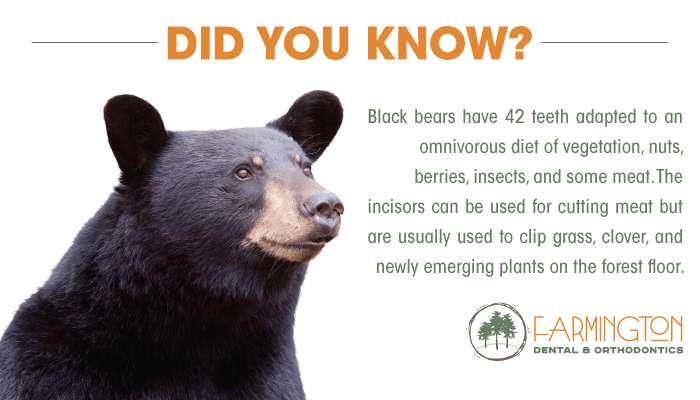
Fruits and nuts and leaves of all kinds… Did you know that black bears eat more than just meat? That’s right, these ‘carnivores’ are actually omnivores like us and have similar teeth.
In fact, the smallest North American bear has a very opportunistic diet. What they eat depends on what’s easily available and that changes with the seasons: tree buds, plants (including pollen and flowers), roots, berries, seeds, nuts, bugs of all kinds, and occasionally, even fish or meat! A black bear has 42 teeth that work perfectly for such a varied diet.
Incisors
Black bear incisors are occasionally used for slicing through meat, but their most common use is for ‘mowing’ the forest floor. Juicy grass, sweet clover, delicious dandelions, and tender young shoots all fall ‘prey’ to a black bear’s incisors.
Tender young vegetation is easily digested, nutritious, and high in protein. That makes it ideal for recovering from the effects of their long winter nap. Young plants and shoots make up to 90% of their diet in spring and early summer when berries and nuts aren’t available yet.
Canines
These teeth come in handy for slashing ground squirrels or other small animals. That is, when they’re not busy ripping into logs in search of grubs and ants. Yum!
Most of the meat they eat is from the carcasses of winter-killed animals and other carrion, the occasional lucky killing of a fawn or other young animal, and insects. Less than 10% of their diet consists of meat and most of that ‘meat’ has at least six legs!
They relish forest tent caterpillars and springtails, but they direct most of their predatory attention toward colonies of social insects like bees, wasps, and ants. Those canines are very handy for tearing apart logs to reach the yummy larvae and pupae hidden deep within.
They’ll even use those canines to rip apart bee hives in search of larvae – served with a side of honey, of course!
Premolars
Unlike the two premolars most human adults have between each of our canines and molars, bears have four. However, their bottom jaw is usually missing the second and third premolars to leave a gap, or diastema.
That kind of gap is common in herbivores. It’s handy for grabbing a twig or stem and letting it slide through the gap sideways while stripping off all the leaves. Bears use it similarly, including stripping new buds off the twigs at the top of poplar trees!
Molars
They have two molars on top and three on the bottom of each side. Unlike the razor-sharp molars of cougars and wolves, a black bear’s molars are more like ours. Just like we use our broad, flat molars for grinding up a raw carrot, bears use theirs for grinding acorns, nuts, and all that vegetation they eat.
They give those molars a real workout in the fall when the acorns, hickory, and other nuts ripen. Acorns are a rich source of the carbohydrates, fats, and protein they need to sustain them through the winter to come.
Bears chomp on acorns greedily – after all, every acorn counts towards surviving a cold winter! They need to consume at least 20,000 calories a day – that’s 18 pounds of acorns.
Fortunately, you don’t need to consume quite that many calories each day. You’ll still want to keep your teeth in good condition, though. That’s where we can help!
Our small-town hospitality will make you feel like part of our Farmington Dental and Orthodontics family while Dr. Trogdon and his wife Dr. Stroope will give you the healthy, straight, and beautiful teeth any Arkansas bear would envy!
